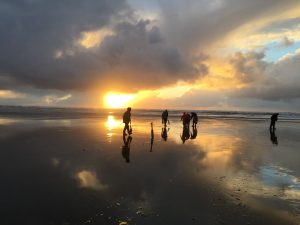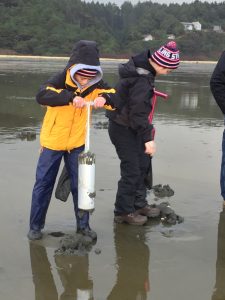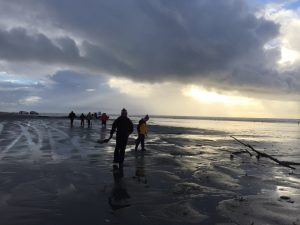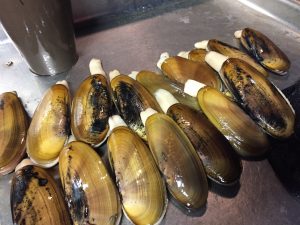First coastal razor clam digs of fall season begin Friday, and expect a mixed bag of sizes Leave a reply
Coastal razor clam lovers have go ahead to proceed on four coastal beaches this Friday and Saturday (Oct. 6-7) for the first digs of the 2017-18 season.
“Our summer assessments showed the amount of clams in general is down this coming season, but depending on the beaches it should be good,” said Dan Ayres, the head state Fish and Wildlife coastal shellfish manager. “The latest toxin testing show clams are safe to eat so we can proceed as planned. The test at Twin Harbors was at 10 parts per million (cutoff is 20 ppm), and all the rest of the beaches were single digits.”
Digging will be allowed Friday (a minus-0.4 feet low tide at 7:49 p.m.) and Saturday (-0.7 at 8:33 p.m.) at Long Beach, Twin Harbors, Copalis and Mocrocks.
Digging is usually best about an hour or two leading up to the low tide change, which means some of the digging period will occur during daylight hours if the skies are clear.
Ayres noted that marine toxin samplers found plenty of clams on beaches north of Grays Harbor especially at places like Mocrocks, and the majority are small, little guys measuring about 3 ½ inches. As is the case when the season opens in autumn those smaller clams are growing into the fishery, and will get bigger in time for the spring digs.

Sunsets can be dramatic during fall and winter evening low tides, and razor clam digging off coast should be decent. Photo by Mark Yuasa.
“The stock assessment gives us numbers, but it doesn’t give an overall sense of what is there,” Ayres said. “We didn’t have any problem getting clams during our assessments in particular at Mocrocks and Copalis.”
The news might not be so rosy for those heading to the southern coast where places like Long Beach lost of lot of clams. The likely downfall was sparse feed and nutrients, and the lower than normal salinity levels due to all the freshwater runoff in the Columbia River this summer. The clams leftover last spring were not fat clams at Long Beach so they also might be on the slimmer size.
Twin Harbors also saw a decline in the clam population, but to a slightly lesser degree.
Daily limit is the first 15 clams dug regardless of size or condition, and diggers must keep the first clams they dig, which means no high-grading. Each digger’s clams must be kept in separate containers.
During the upcoming season there will be a group of researchers from the University of Maryland interviewing recreational razor clam harvesters.
A federal grant by the school will have volunteers out on beaches seeking volunteers to conduct a paid interview for a survey on razor clam consumption and harvesting practices.
“Lynn Grattan, PHD MD researcher for the University of Maryland did a seven-year long-term study on tribal people who eat a lot of razor clams and is seeking answers to questions about people who consume more than 15 clams per month,” Ayres said.
While diggers don’t eat that many clams in a month, the Department of Health has a warning on their website at https://www.doh.wa.gov/CommunityandEnvironment/Shellfish/RecreationalShellfish/Illnesses/Biotoxins/DomoicAcidinRazorClams.
“Part of this study is to determine the effect on people that could lead to long-term memory loss if they consume more than 15 clams a month even with small amounts of domoic acid,” Ayres said. “We don’t want to scare people, and in fact I’ve consumed more than 15 in a month, but in general most of us don’t so the likelihood of any ill effects is very minimal.”
Fall and winter razor clam digs occur during evening low tides while spring-time digs occur during morning low tides.
Dates have been set through Dec. 31, and as mentioned above each series hinges on marine toxin testing before opening.
Other dates planned are:
Nov. 2 (0.1 at 6:03 p.m.) at Copalis; Nov. 3 (-0.7 at 6:47 p.m.) on Long Beach, Twin Harbors and Mocrocks; Nov. 4 (-1.2 at 7:31 p.m.) on Long Beach, Twin Harbors and Copalis; and Nov. 5 (-1.4 at 7:16 p.m.) on Long Beach, Twin Harbors and Mocrocks.
Dec. 1 (-0.3 at 4:42 p.m.) at Copalis; Dec. 2 (-1.1 at 5:29 p.m.) on Long Beach, Twin Harbors and Mocrocks; Dec. 3 (-1.6 at 6:15 p.m.) on Long Beach, Twin Harbors and Copalis; Dec. 4 (-1.8 at 7:02 p.m.) on Long Beach, Twin Harbors and Mocrocks; and Dec. 31 (1.2 at 5:12 p.m.) on Long Beach, Twin Harbors, Copalis and Mocrocks.
For more information, go to http://wdfw.wa.gov/fishing/shellfish/razorclams/.
Oregon opens northern beach for razor clam harvest
Just across the Columbia River on the Oregon side, Clatsop County beaches reopened this past Sunday after being closed since July of 2016, the Oregon Department of Fish and Wildlife reported.
The closure was necessary due to elevated levels of marine toxins and a closure to protect newly set young clams from July 15 through Sept. 30 that occurs yearly.
Other Oregon beaches have remained open for razor clam digging, but Clatsop County beaches are the most popular spot and make up 90 percent of state’s harvest.
During the summer of 2016, diggers found a bounty of clams during a record year with the majority of diggers attaining their 15-clam daily limit.

Tegan Yuasa (left) and Taylan Yuasa (right) try their luck for razor clams last winter at Copalis Beach.
When the beaches reopen it is likely that diggers will find a different scenario since surveys found abundance levels significantly lower since surveys began in 2004.
“In 2016, abundance peaked and surveys estimated 16 million razor clams in the 18-mile stretch between the Columbia River south jetty and Tillamook Head,” Matt Hunter, the ODFW’s Lead Shellfish Manager said in a news release. “This year, the estimate is just 3 million clams in that area.”
“These low numbers are troubling, as they mean Clatsop beaches haven’t seen a significant recruitment event for two years,” Hunter said. “But this recruitment issue is not isolated to just Clatsop beaches. It’s being seen on the entire Oregon coast and for Washington beaches, too.”
Despite total numbers being down, diggers will find larger-sized clams averaging about 4 ½ inches with only a few clams smaller than 4-inches. Surveys showed clams distributed sporadically along the entire stretch of the beach.
“While razor clam numbers are lower this year, clams are quite large,” Hunter said. “To be successful, clammers should be diligent, choose the best low tides and actively ‘pound’ to get razors to show.”
The daily limit is the first 15 clams dug regardless of size or condition, and sorting or releasing clams isn’t allowed.
Before heading to an Oregon diggers should call 800-448-2474 or go to http://www.oregon.gov/ODA/programs/FoodSafety/Shellfish/Pages/ShellfishClosures.aspx.



